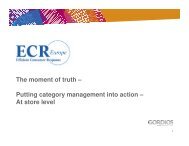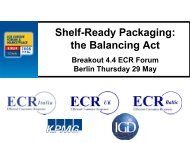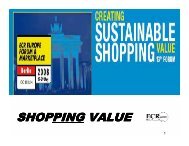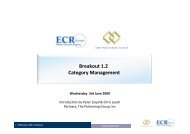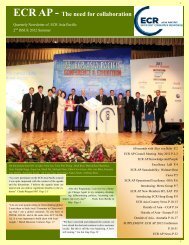Create successful ePaper yourself
Turn your PDF publications into a flip-book with our unique Google optimized e-Paper software.
Figure 31: Success factors for the consistent flow of Efficient Unit Loads<br />
A<br />
B<br />
C<br />
D<br />
• Easy-to-open and shelf-ready secondary loads or use of re-usable boxes from MDC or even<br />
point of manufacturer<br />
• Manufacturer/retailer harmonised tertiary item (pallet, roll cage, or dollies) with continuous<br />
application up to point-of-sale<br />
• Retailer/manufacturer consistent tertiary items (pallets, roll cages or dollies)<br />
• Synchronised heights of tertiary unit loads<br />
• Flexible order volume management to use capacity of tertiary items<br />
• Harmonised secondary items/dimensions to facilitate automated bulk breakup<br />
• Maximisation of pallet height (in-bound RDC/outbound MDC)<br />
• Flexible order volume management to allow shipment of original ‘one product’ pallets<br />
(minimum picking at MDC)<br />
• Harmonised storage equipment to allow tertiary unit loads to be hauled without adjustment<br />
and optimal use of transport capacity<br />
• Introduction of reusable boxes for small volume SKUs which are demanded as single primary<br />
packages at store<br />
Source: A.T. Kearney, Efficient Unit Loads project<br />
There is no single optimum solution for all types of<br />
product flows and it is unlikely that there will be one<br />
universal solution for all supply chain participants. As<br />
technology advances, existing targets, standards,<br />
procedures and compromises must be reviewed and<br />
changed accordingly.<br />
The Efficient Unit Loads Report 59



